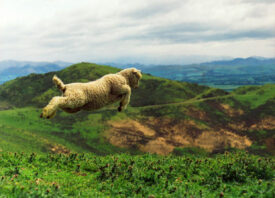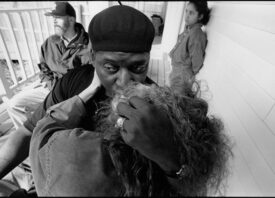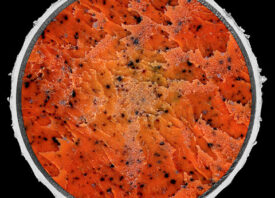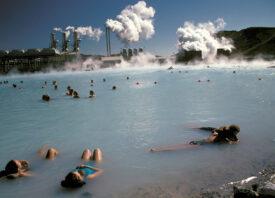Search this site
National Geographic’s Maura Friedman on Capturing Meaningful Moments

In the past year and a half, National Geographic’s Maura Friedman has worked with photographers to cover some of the most urgent issues of our time, taking us behind the headlines to reveal untold or overlooked stories. She worked with the photographer Chiara Goia as she documented the lives of Italy’s funeral home workers just weeks after the height of the pandemic. When Jared Soares shared the experiences of people of color at living history sites, Friedman supported the project behind the scenes.
With a background as a picture and video journalist, Friedman’s responsibilities at National Geographic include commissioning and curating photography for NationalGeographic.com and front of the magazine. As part of the leadership team at Women Photojournalists of Washington, she’s also helped nurture the careers of emerging photographers who identify as women, while educating the public about their contributions to the field.
This year, we’re thrilled to have Friedman as one of the jurors for the 7th Annual Feature Shoot Emerging Photography Awards. In anticipation of our deadline for submissions on September 3rd, we asked her a few questions about her work.

Can you walk us through a day in your life as a photo editor at National Geographic?
“My work falls into a few buckets — photo research for text-driven stories, licensing existing photo projects for digital or print packages, photo commissions for shorter, single location stories, and the research, development, and support behind magazine feature stories.
“In every case, my first step is to vet visual potential. If we’re licensing, are the photos and the narrative consistent with our standards? If we’re commissioning, will the situations be visually interesting or surprising? Great stories aren’t always a great fit for National Geographic. We have a significant emphasis on photography.
“The best part of my job is always collaborating with photographers. The most inspiring part is when photographers are proud of the work they did on assignment with me.”

Is there any one story or project from your time at National Geographic that you’re particularly proud of?
“Working with photographer Muhammad Fadli recently to tell a deeper story about the COVID crisis in Jakarta was very meaningful. The first project I pitched to and licensed for National Geographic was his Rebel Riders portfolio, so in that aspect, working with him on assignment felt personally full-circle.
“Muhammad and I have similar communication styles and ways in which we think, so our collaboration felt very second-nature. And he’s just such a talented journalist. It was an honor to help shepherd his work. And of course, I’m really happy with the photos and the edit. In a relentless pandemic news cycle, I’m appreciative to have the time and resources to report fully on the urgent connection between public health, economic decline, and nutrition.”

Does your background as a visual journalist yourself inform your work as an editor?
“Absolutely, but it’s taken time to meld the perspectives. Initially, I worked with photographers as the type of editor I liked working with as a photographer (very involved, technically specific, driving the production), which just doesn’t pull the best work out of everyone. I’ve since learned how to have conversations with photographers upfront about the type of collaboration and support that serves them best.
“One of my greatest strengths as an editor is my ability to see the mindset and habits of a photographer through their full take. That diagnostic aptitude absolutely comes from my own experience in the field. I can identify when photographers were nervous, when they were comfortable, and what photos they were trying to make, even if the frames weren’t successful. This leads to deeper and more productive conversations with folks about how to sharpen their work or build on their success. This is especially rewarding mid-assignment when the story is still developing.”

You’re also on the team at Women Photojournalists of Washington. Why is it important to you to help uplift and nurture the next generation of women photojournalists?
“I recognize and am deeply grateful to all the women who have supported and encouraged me throughout my career and continue to do so. In almost every opportunity I’ve had to prove myself, a woman has opened that door. Consequently, I value spaces that also open doors and share knowledge and experience widely.
“This can be a very opaque industry, but building community cuts through that. I’m also a bit selfish — I want to learn from and alongside the next generation of storytellers! I joke that my role in planning WPOW’s quarterly speakers is just my excuse to enlist women and non-binary folks in photography who I admire to talk to me—and for me to pay them.”
What kind of work do you look forward to seeing in this year’s Emerging Photography Awards?
“I look forward to seeing moments, always. Aesthetic trends in photography come and go (and I happen to like the current focus on film, sparse spaces, and warm tones), but a moment in a frame always elevates the image. The decisive moment can’t be beat. It’s what I’m always pushing for with photographers I’m working with.
“I’m interested in photographers taking stock of their specific perspective and what new revelations can be drawn from that. Focusing the question ‘what are your stories to tell?’ to center ‘How would my perspective add to or upend our existing understanding of this story?’ That is a powerful place to ideate from.”
The Feature Shoot Emerging Photography Awards is open for both single-image entries and series entries. Maura Friedman will be one of this year’s single-image jurors. There’s still time to submit your work; learn all the details by visiting our website.



